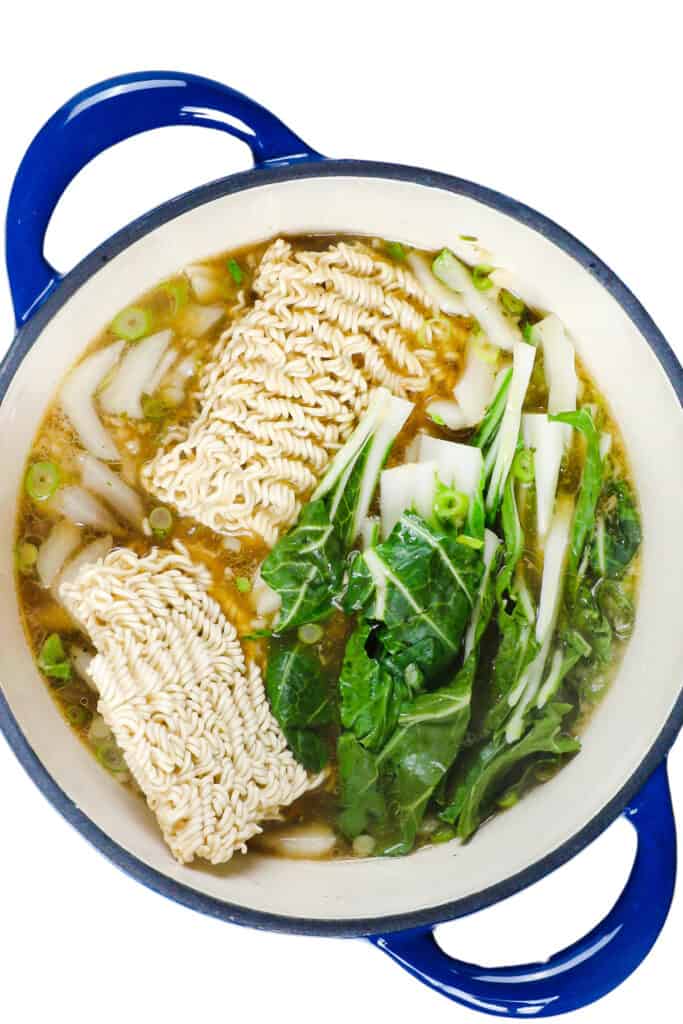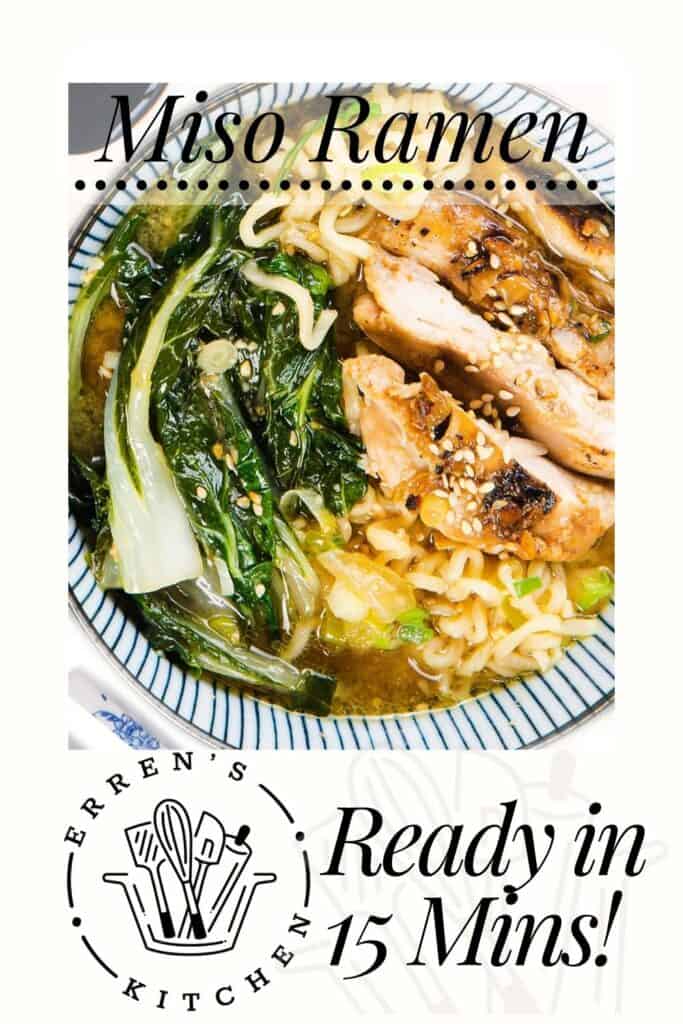Ready to explore the flavors of Japanese cuisine? Start with delicious Miso Ramen, a flavorful and versatile soup ready in just 15 minutes.

Miso Ramen is a classic Japanese dish that has gained immense popularity worldwide. It is a comforting and flavorful noodle soup that is packed with umami-rich ingredients like miso paste, soy sauce, and mirin. In this post, we’ll share a recipe that has been tried and tested to yield a bowl of ramen that’s bursting with flavor and easy to make. So, let’s dive in!
Why This Recipe Works
- Sautéing the garlic and green onions in sesame oil adds a depth of flavor to the soup, making it more aromatic and flavorful.
- Combining broth with miso paste, soy sauce, and mirin creates a well-balanced, umami-rich broth that is savory, slightly sweet, and satisfying.
- Adding bok choy to the soup not only provides a pop of color but also adds a slight bitterness to the soup, balancing out the sweetness from the mirin.
- Cooking the noodles in the soup saves time and energy and allows the noodles to absorb the flavors of the broth, making each bite of the soup more flavorful and satisfying.

Miso Paste Buying Guide
Miso paste is a unique and flavorful ingredient that is widely used in Japanese cuisine. It is made by fermenting soybeans, and the flavor and texture can vary depending on the fermentation process and the duration of fermentation.

The two most common types of miso paste are red and white, both of which can be found in grocery stores and used in various recipes, including Miso Ramen. White miso paste is milder and sweeter than red, making it a perfect choice for those who prefer a less intense flavor.
You can typically find miso paste in the refrigerated section of most grocery stores, often near soy products like tofu. It is also available in Asian markets and online retailers. You can buy the miso paste I used on Amazon (paid link).
Using Dashi Broth
This recipe calls for either dashi broth or chicken stock. Dashi broth is a traditional Japanese broth made by simmering kombu (dried kelp) and katsuobushi (dried bonito flakes) in water.

The resulting broth is light and clear with a subtle umami flavor, a cornerstone of Japanese cuisine. Dashi broth is used as a base for many Japanese dishes, including Miso Ramen, miso soup, and udon soup.
If you don’t have access to Dashi Broth and want to use it for soup, you can buy Dashi Powder (paid link) to make a quick and easy version.
Ingredient Notes

- Sesame Oil: Light sesame oil is the best choice for this recipe as it has a mild flavor that won’t overpower the other ingredients. You can substitute it with any other neutral oil, like vegetable or canola.
- Garlic and green onions: Fresh garlic and green onions (AKA scallions or spring onions) are preferred, but you can also use garlic and onion powder if you don’t have fresh ones on hand.
- Dashi broth or chicken stock: Dashi broth is the traditional choice for Ramen Miso as it adds a distinct umami flavor. You can substitute it with chicken or vegetable stock if you can’t find dashi broth.
- Miso paste: You can use either white or red miso paste, depending on your preference. See the above buying guide for more information.
- Soy sauce: We recommend low-sodium soy sauce as miso paste can be salty. Start with a tablespoon as called for in the recipe and adjust as needed. Use a good-quality soy sauce for the best flavor.
- Mirin: A sweet Japanese rice wine that subtly sweetness the soup. If you don’t have mirin, you can use rice vinegar or sake instead.
- Bok choy: Also known as pak choi, you can use large leaf or baby varieties. You can substitute it with other leafy greens like spinach or kale.
- Ramen noodles: Use whatever ramen you like best. If you can’t find them, you can substitute them with other types of Asian noodles, such as udon or soba.
Step By Step Instructions
Heat the sesame oil over medium heat in a large pot or Dutch oven. This will help bring out the sesame oil’s nutty flavor and create a flavorful base for the soup.

Add the minced garlic and sliced green onions to the pot and sauté for 1 to 2 minutes until they are fragrant. The garlic and green onions will add depth of flavor and aroma to the soup.

Pour in 4 cups of dashi broth or chicken stock and bring the mixture to a boil. The broth will help to create a savory and umami-rich base for the soup.

Reduce the heat to a simmer and add 3 tablespoons of miso paste, 1 tablespoon of soy sauce, and 2 tablespoons of mirin to the pot.

Use a whisk or a fork to stir the ingredients together until the miso paste is completely dissolved. This will help to evenly distribute the flavors and create a smooth and velvety texture. Then add the chopped bok choy and 6 oz of ramen noodles to the pot.

Simmer for 3 to 4 minutes until they are tender and cooked through. The bok choy will add a fresh and crunchy texture, while the ramen noodles will help to make the soup more filling and satisfying.

Divide the noodles among serving bowls.

Then ladle the miso broth over the noodles.

Divide the bok choy into the bowls and serve hot topped with your favorite toppings. The combination of savory broth, tender bok choy, and hearty ramen noodles will make for a satisfying and flavorful meal.

Topping Suggestions
- Protein: Sliced Miso Chicken, braised pork belly, shredded chicken, tofu, or a soft-boiled egg.
- Vegetables: Steamed bok choy, sautéed spinach, bean sprouts, corn, sliced green onions, or sautéed mushrooms.
- Seaweed: Nori sheets, wakame, or kelp.
- Spice: Chili oil, spicy bean paste, or thinly sliced fresh chili peppers.
- Pickles: Bamboo shoots, pickled red ginger, or pickled mustard greens.
- Herbs: Chopped cilantro or shiso leaves.
- Extra flavor: Crushed garlic, sesame seeds, or a small dollop of butter for a richer taste.
Feel free to mix and match these toppings to create your perfect bowl of Miso Ramen soup. Enjoy!
Erren’s Top Tips
- Don’t overcook the noodles: Overcooked noodles can become mushy and lose their texture, affecting the dish’s overall taste and appearance. Be sure to follow the package instructions and cook the noodles until they are tender.
- Dissolve the miso paste: To ensure it is evenly distributed and dissolved in the broth, add it to the pot after reducing the heat to a simmer. Use a whisk or a fork to stir the paste into the broth until it’s completely dissolved.
- Adjust the seasoning: Miso paste can vary in saltiness, so it’s important to taste the soup after adding the miso paste, soy sauce, and mirin to ensure the seasoning is to your liking. Adjust the seasoning as necessary by adding more miso paste, soy sauce, or mirin.
- Use high-quality ingredients: The quality of the ingredients can greatly affect the taste and overall quality of the soup. Use fresh bok choy, high-quality miso paste, and flavorful broth to ensure the soup is flavorful.
Storage & Freezing Instructions
To Store Leftover Miso Ramen: I suggest storing the noodles separately to be sure they don’t absorb the broth. Allow the soup to cool to room temperature and transfer it to an airtight container. Refrigerate the soup for up to 4 days. When reheating, gently warm the soup over low heat to prevent overcooking the noodles and vegetables.
Freezing Instructions: Allow the soup to cool completely and then transfer it to an airtight, freezer-safe container or plastic bag. Freeze the soup for up to 3 months.
To Reheat: Thaw the soup overnight in the refrigerator and gently warm it over low heat. Please note that the texture of the noodles may change slightly after being frozen and thawed, but the flavor should remain delicious.
Stay Updated
Receive new recipes & dinner ideas straight to your inbox!

Let’s Make Miso Ramen
Ingredients
- 1 tablespoon light sesame oil
- 2 garlic cloves minced
- 2 green onions sliced
- 4 cups dashi broth or chicken stock
- 3 tablespoons miso paste
- 1 tablespoon soy sauce
- 2 tablespoons mirin
- Bok choy chopped
- 6 oz ramen noodles fresh or dried
Instructions
- In a large pot or Dutch oven, heat the sesame oil over medium heat. Add the minced garlic and sliced green onions, and sauté until fragrant, about a minute.
- Add the dashi broth or chicken stock to the pot and bring to a boil.
- Reduce heat to a simmer and add the miso paste, soy sauce, and mirin to the pot. Stir well to combine and dissolve the miso paste.
- Add the chopped bok choy and fresh or dried ramen noodles to the pot. If using dried noodles, break them in half before adding to the pot. Stir well to ensure that the noodles are submerged in the broth.
- Cover the pot and simmer for 3 to 4 minutes until the noodles are tender and cooked through. If using fresh noodles, they may only take 1 to 2 minutes to cook.
- Once the noodles are cooked, ladle the miso broth and bok choy over the noodles and serve hot.
















Cris says
This is delicious! I will certainly be making this again, especially if I have a heap of spring onions to use up
Erren's Kitchen says
That is great!! So happy you loved it!
Jaya says
I want to say, I love your food! The photography is outstanding. Thank you for moving back to the US. Enjoy the weekend!
Erren's Kitchen says
This is such a sweet message. Thank you so much for being here!!! 🥰
Wilma B says
Your flavours are wonderful.
Thank you for creating such a nutritional meal in a bowl.
I am ADDICTED to noodles.
I have changed the methodology a bit and Get my broth really really HOT cook noodles – and watch so not mushy ( they cook faster if broken) then remove from broth and set aside covered with some broth and a lid.
I then add chopped and some of quartered pieces of Bok Choy to broth to wilt as I raise the heat.
Bowl is filled with noodles on bottom ( just as you did Erren ) and add steamed broccoli and wilted Bok Choy and HOT broth over noodles.
This way I can have another bowl later on and nothing is mushy.
I love that ramping up the heat of my broth ( just before serving) does all the work for me.
Thanks again Erren.
Erren's Kitchen says
Wilma, thank you so much for your kind words and feedback! We’re thrilled to hear that you enjoyed the flavors of the soup and found a method that suits your taste. Your adaptation with the hot broth, perfectly cooked noodles, and the addition of steamed broccoli and wilted Bok Choy sounds absolutely delicious! It’s fantastic to see you making the recipe your own and creating a satisfying and personalized bowl of goodness!
Erren Hart says
Your comment put a smile on my face. I’m happy that the recipe was a hit for you.
Becca says
I love this soup! I’ve made it a few times now and can’t get enough!
Erren Hart says
Thank you for taking the time to comment and share your positive experience with the recipe. I’m delighted that it turned out well for you!
Kevin loveless says
made it and loved it. it was fast and easy to make and I’ve had to write the recipe and method down in my family cookbook. thank you
Erren's Kitchen says
Kevin how awesome!! I love that you added it to the family cookbook! Thank you so much!
Daniellle says
I made this with your miso chicken. They were both fantastic! Thanks, Erren!
Erren Hart says
Thank you for trying out both the miso ramen and miso chicken recipes and leaving such a positive comment! We’re delighted to hear that you found both dishes to be fantastic and enjoyed them. We really hope you’ll try the other dishes we’ve made in the future.